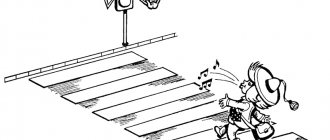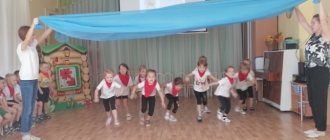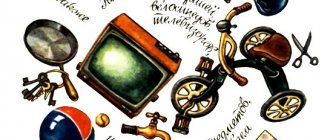Conversation on the topic “Rules for pedestrians”
Conversation on the topic “Rules for pedestrians” senior group
Program content
Expand children's knowledge about the rules of behavior on the street, introduce children to the pedestrian crossing and talk about the rules of behavior on it.
Develop observation and reaction speed. Cultivate a desire to comply with traffic rules. Methodology Educator
Every year the number of vehicles on the city streets increases.
Day and night, cars, buses and other vehicles move along the roads in a continuous stream. Therefore, everyone who likes to take a walk, everyone without exception, needs to remember, needs to know the traffic rules. Children should, when leaving the house on the street, listen and look closely to see if there are cars nearby. Danger can lie in wait both on the street and in courtyards where cars drive in and out. Therefore, you need to be very attentive and observant, learn to see everything that is happening around you. What do you call people walking down the street? Children
Pedestrians.
Educator
You and I are also walking along the street, which means we are pedestrians.
In order not to interfere with traffic, pedestrians must follow traffic rules. Let's remember how to walk down the street? Children
You need to walk along the street at a calm pace. Walk along the sidewalk on its right side. Cross the road at a pedestrian crossing when the traffic light is green.
Educator.
How did you know that this is where you can cross the road?
Children
There is a pedestrian crossing sign and wide white zebra stripes are drawn on the road.
They are far visible to both pedestrians and drivers. Striped paths, laid under your feet. So that you don’t know your worries, And you walk forward along them, Educator.
To continue our conversation, you need to guess the riddle: He blinks his eyes Tirelessly day and night. He helps cars and is ready to help you!
The guard watches vigilantly behind the wide pavement. As soon as he looks with a red eye, they will all stop at once. And the green ones will wink - Both the cars and the people go forward!
Children .
This is a traffic light.
teacher
!
Guys, what is a traffic light for? Children:
A traffic light is needed to regulate traffic so that there is order on the streets and roads.
Educator:
Do you all know what each traffic light signifies?
Educator
: Let's repeat with you Red is a dangerous color, This means there is no move!
Yellow – don’t rush, and wait for the signal! The color green says: Now the way is open for you! Educator
Traffic lights allow or prohibit crossing the street. Now let's see how people cross the street. Where there is a noisy intersection, Where there are too many cars to count, Crossing is not so easy, If you don’t know the rules. Let the children firmly remember: It is true that the one who walks across the street only when the light is green acts!
Let's determine what kind of traffic is on the street? Bilateral or unilateral. Features of crossing the street (for one-way crossing, before starting the crossing, look in the direction where the traffic is moving; for two-way, look to the left; after making sure that the cars have stopped, walk along the pedestrian crossing, having reached the middle, look to the right and if the green light is still on, continue crossing.) To live , without knowing grief, in order to run, swim and fly, you must follow the rules of movement, always and everywhere. Be careful on the street, children! Remember these rules firmly. Remember these rules always, so that trouble does not happen to you! Educator:
You guys are great, you answered all the questions. The main thing is that you grow up to be competent pedestrians, you know the Rules of the Road. You have firmly learned that you not only need to know the rules, but you also need to follow them.
The city in which you and I live can rightfully be compared to the ABC book of streets, avenues, roads. The city always gives us a lesson. Here it is - the alphabet above your head: We see signs everywhere with you. Always remember the alphabet of the city, so that trouble does not happen to you.
Series of conversations “About traffic rules”
A series of conversations about road safety for primary school students in the Municipal Budgetary Institution of Preschool Children's School (Yu)T in Salavat
Prepared by:
teacher-organizer
L.S. Biktimirova
2017
A series of conversations about road safety for primary school students in the Municipal Budgetary Institution of Preschool Children's School (Yu)T in Salavat
CONVERSATION 1. Traffic rules:
Responsibilities of drivers, pedestrians and passengers.
Target:
Strengthen students' knowledge about safe movement.
Content:
Their main goal of the Road Traffic Rules is to ensure safety for all participants and traffic organizers.
Traffic rules are a single document establishing the rules of traffic on the territory of our country.
Road users are required to know and strictly comply with the Rules, orders of police officers and persons authorized to regulate traffic, as well as the requirements of traffic lights, road signs and road markings.
Violation of the Rules entails liability in accordance with current legislation.
Drivers' responsibilities
The nature of a driver’s job requires him to be highly disciplined, take initiative, and be resourceful.
The driver must take care of the car, know its structure well, always keep it in good technical condition, drive it skillfully, observing the traffic rules. While driving a car, you should not talk to passengers - this could cause an accident. When driving a car, the driver should rely solely on himself, always be careful, self-controlled and attentive; Only under this condition will accident-free driving be ensured.
Responsibilities of pedestrians
Pedestrians should only walk on sidewalks or walkways. If there is no sidewalk, pedestrian or bicycle path, or shoulder, or movement on it is impossible, the pedestrian can walk along the roadway), and outside the populated area - towards the movement of vehicles.
Organized columns of people must move on the right side of the roadway in no more than four rows, without interfering with vehicles. I walk ahead and behind the column on the left side, accompanied by red flags, and in the dark and in conditions of poor visibility - with lit lanterns: in front - white, in back - red.
Groups of children can walk on sidewalks and pedestrian paths, and if there are none, on the side of the road during daylight hours and only when accompanied by adults.
Pedestrians must cross the road along underground passages, pedestrian bridges, in places marked with markings or signs, and on sections of roads where there are no marked pedestrian crossings, at intersections along sidewalks or curbs, between them - at right angles in places where it is clear is being viewed.
In places where traffic is regulated, pedestrians are required to follow the signals of the traffic controller or traffic light. When crossing the road, you must not stop on the roadway. If pedestrians do not have time to complete the crossing, they should stop at the traffic island.
When special vehicles approach, pedestrians must refrain from crossing the roadway.
Passenger Responsibilities
Passengers can wait for a bus, trolleybus, tram, or taxi only on boarding platforms, on sidewalks, or on the side of the road.
You can enter and exit public transport only after a complete stop and only from the sidewalk, curb or edge of the roadway.
Passengers are prohibited from: distracting the driver from driving the vehicle while it is moving; open the doors of the vehicle while it is moving
CONVERSATION 2. Traffic rules:
Traffic organization, technical means of traffic control.
Target:
continue to develop knowledge and ideas about safe movement on streets and roads.
The composition of traffic participants on the roads and streets is very diverse. Some move at high speed, others at low speed. All this creates conditions of mutual danger in motion.
The main thing in the characteristics of traffic is its intensity, i.e. how many cars, tractors, bicycles, etc. and pedestrians passed and passed through a certain section of the street (road) per unit of time (hour, day, month, etc. ). The intensity of traffic and pedestrians varies throughout the day - it increases at the beginning and end of the working day, weakens in the middle of the day and especially at night.
For traffic safety, one-way traffic is organized in cities and on roads, in which vehicles move only in one direction. For oncoming traffic, choose another street. The simultaneous movement of vehicles and pedestrians causes great mutual interference, often leading to traffic accidents.
Traffic control is organized at intersections of streets and roads. If some city streets and country roads do not meet modern technical requirements, this makes it difficult to ensure traffic safety.
Technical means of traffic control are used to improve traffic safety.
The order of movement is regulated by such technical means as a traffic light. Traffic lights are convenient because their signals are clearly distinguishable both day and night. Technical means also include road signs.
They inform drivers about traffic conditions on different sections of the road. With the help of signs, restrictions and prohibitions are established, warnings are given about dangerous places on the roads, etc. The shape, size and color of the signs must be clearly visible against the background of the area. The content of the signs is indicated by conventional drawings that are visually well perceived by drivers. To make signs better visible at night, the images on them are made with reflective paints or illuminated.
If the means of regulation are inconsistent, drivers must follow the signals of the police officer, not the traffic light, and the instructions of the road signs, not the markings. If the meanings of traffic light signals contradict the requirements of road signs, drivers are guided by the traffic light signals.
Compliance with signals and instructions of any means of regulation is strictly mandatory for all road users.
CONVERSATION 3. Traffic rules
Traffic light regulation. Passage of special vehicles.
Target:
Repeat and consolidate knowledge about traffic lights and traffic controllers.
Currently, traffic on the street is unthinkable without regulation by traffic lights and traffic controllers. Traffic lights are used to regulate traffic at intersections, squares and pedestrian crossings, and for signaling at railway crossings.
1. The green signal allows movement.
2. A green flashing signal allows movement and informs that its duration is running out and the prohibiting signal will soon turn on.
3. A yellow signal prohibits movement and warns of an upcoming change of signals;
4. A yellow flashing signal allows movement and informs about the presence of an unregulated intersection or pedestrian crossing, warns of danger;
5. A red signal, including a flashing one, prohibits movement.
If a traffic light signal is made in the form of a silhouette of a pedestrian (bicycle), then its effect applies only to pedestrians (cyclists). In this case, the green signal allows, and the red signal prohibits, the movement of pedestrians (cyclists).
To inform blind pedestrians about the possibility of crossing the roadway, traffic light signals can be supplemented with an audible signal.
Sometimes, in special situations (road repairs, traffic jams), the traffic light does not work, and a person in uniform directs traffic at the intersection. This is a traffic police inspector. Car drivers obediently follow his commands, and a clear order is established on the roadway. But not only drivers, but also pedestrians need to know the traffic controller’s signal in order to avoid troubles on the road. Depending on the position of the traffic controller’s body and hand gestures, the crossing is closed or open for us. For better visibility, a wand is often used.
The traffic controller's hand is raised up - the movement of pedestrians and all vehicles in all directions is prohibited. The intersection must be clear. This is done before changing the permitted direction of movement or to allow the passage of emergency services vehicles that have a special coloring, follow with blue flashing lights turned on and give a special sound signal (firefighters, police, ambulance, emergency gas, etc.). If you did not have time to cross the street by the time this signal is given, then stay on the traffic island or, in its absence, on the line dividing traffic flows in opposite directions. We must always clearly remember that drivers who do not have time to stop at this signal in the designated place are allowed not to resort to emergency braking and continue driving.
The traffic controller stands with his chest or back to us (his arms are lowered or extended to the sides) - the path is closed to pedestrians.
The traffic controller is standing sideways to us - the path is open to pedestrians to the left and right of him along the pedestrian paths across the roadway. But the same signal from the traffic controller allows the movement of trackless vehicles straight ahead and to the right. Therefore, you should always look to the left before crossing the road to avoid being hit by cars turning right. It's easy to remember: take care of your left side, where your heart is!
The traffic controller's right arm is extended forward - we are only allowed to pass behind his back, and the path in front is closed.
The traffic controller may also give other signals that are understandable to drivers and pedestrians, which we are obliged to follow, even if they differ from the instructions of the traffic light, mandatory signs and road markings.
Special vehicles are easy to distinguish in traffic thanks to their coloring, a blue flashing light mounted on the roof, and a special sound signal. Such vehicles include: firefighters, ambulances, police, mine rescue and others. Cars and motorcycles are used to carry out rescue operations, eliminate fires, natural disasters, provide emergency medical care, deliver police officers to the scene of an incident, escort convoys of buses, etc.
CONVERSATION 4. Rules of the Road: Road signs
Target:
To consolidate students' knowledge of road signs learned over two years of study.
Contents: Road signs perform the same role as traffic lights, lines marking the carriageway of streets and roads. They help regulate and organize the flow of cars and people, make the work of drivers easier, and help them and pedestrians navigate correctly in difficult traffic conditions.
The teacher tells students that road signs warn pedestrians and drivers about possible danger, indicate possible danger, and oblige drivers to be extremely careful; establish the order of passage through intersections or narrow sections of streets; prohibit any actions by drivers and pedestrians; instruct drivers to move in a certain direction, i.e., follow the instructions indicated on them; inform drivers of different road conditions; contain various information, explanations and help drivers and pedestrians navigate their way; notify about places of rest, gas stations, etc.
Road signs are used in all countries of the world, and transport drivers, arriving in another country, without knowing the language, understand the symbols on the road signs of that country and have the opportunity to drive vehicles on unfamiliar roads.
Road signs are installed on the right side of the road. Road signs, road markings and other technical means of traffic management are of great importance for traffic safety. Therefore, it is prohibited to remove, damage, block signs, damage road surfaces, stack or leave any objects on the roads, or create other obstacles to traffic. Intentional damage to roads, railway crossings and other road structures or technical means of traffic control, and intentional obstruction of traffic will entail a fine.
CONVERSATION 5. Traffic rules. Railway
Target:
To form an idea of safety precautions when moving along the railway track.
Contents: Modern trains move at high speed. The stopping distance is hundreds of meters. You cannot stop the train instantly. Even if a driver notices a person on the tracks, there is practically nothing he can do to prevent his death.
- Remember that children should not walk along railway tracks or play near railways.
- It is strictly forbidden to be in the fenced area of the above-ground metro lines.
- Do not stand on the edge of the platform or platform while waiting for a train - it is life-threatening.
- It is recommended to wait for the train at a distance of at least a meter from the edge of the platform. You can enter the carriage only after passengers have exited and cleared the vestibule. When traveling, passengers should not lean out of the carriage windows.
- Crossing the railway track is permitted only in specified places (at railway crossings) on special bridges and passages located above the railway tracks and through underground tunnels.
Traffic lights, signs, and barriers are installed at guarded railway crossings. When approaching a railway crossing, pedestrians must follow the alarm and signs of the person on duty and the crossing. Every road user must take special care when approaching and driving through a railroad crossing.
CONVERSATION 6. Traffic rules: Responsibilities of pedestrians.
Target:
deepening students' knowledge of the rules of behavior on the street.
Contents: Compliance with pedestrian traffic rules is an element of human behavior culture.
The rules of behavior on the street developed as a result of extensive experience in the life of society. All students must follow these rules.
- You must walk along the street at a smart pace, at a moderate pace, and only on the sidewalk or pedestrian crossing, keeping to the right side so as not to disturb others;
- You cannot walk in a row of several, more than two people, or in a large group - this interferes with others; You cannot play on the roadway (road), this is not a place for games;
- When meeting a friend, you should not stop to talk in the middle of the sidewalk, you must step aside;
- Throwing pieces of paper, fruit peels, etc. is prohibited. There are trash cans and bins for this; in addition, passers-by can step on fruit peels, slip and fall;
- With the onset of the first frosts, you cannot skate on the sidewalks or turn them into an ice skating rink: pedestrians may slip and fall;
- In narrow places on the sidewalk you must give way to adults;
- One must always be attentive to elders and help them;
- You must not push, as this may cause others to step onto the roadway and put their lives in danger;
- If you accidentally push someone or step on someone's foot, etc., you must politely apologize;
- Address people who are blocking your passage with the words: “Please let me through”;
- If you see that your friend or any of the younger ones is going to break the traffic rules, stop them;
No public events may be held on the road without permission from road authorities and police;
You cannot light a fire on the road (in the right-of-way) or within 100 m of wooden bridges;
If you see any malfunctions on the road or artificial structures (bridges, tunnels, etc.) that threaten traffic safety, immediately notify the road authorities and the police.
It is necessary to take care of green spaces along the road, snow protection devices, road signs and indicators.
Pedestrians violating traffic rules can be divided into two groups:
1. Those who do not know their rights and obligations provided for by the Traffic Rules, or who know them and cannot apply them in practice;
2. Those who know the rules of the road, but intentionally or through negligence neglect them.
An analysis of road traffic accidents shows that a significant number of them occur because pedestrians do not understand the signals of a traffic controller or a traffic light, are poorly oriented in the traffic situation, and sometimes deliberately neglect traffic safety requirements, allow themselves to deliberately cross the roadway when the traffic light is prohibiting, cross street outside pedestrian crossings. A pedestrian can: be warned, fined, provided with information at the place of work or study, etc.
CONVERSATION 7. Final lesson on the rules of safe behavior
Target:
To form students’ ideas about the role of the public in matters of road safety; cultivate a respectful attitude towards the driver’s work.
Content: The teacher tells the children that the work of a driver is very intense and responsible. In our country, more than two-thirds of transportation of national economic goods is carried out by road transport. Therefore, the implementation of production plans by enterprises largely depends on drivers. One of the main indicators for assessing the performance of drivers is accident-free operation. Statistics show that on average 70% of road accidents are caused by drivers. Therefore, traffic safety largely depends on how vehicle drivers know and follow the traffic rules.
Currently, the profession of a driver is one of the most common professions. At the same time, the profession of a driver is one of the most difficult. He must know and strictly follow the Traffic Rules, have a quick reaction, good vision and hearing. On the way, the driver must have time to respond to traffic lights and traffic controllers, follow road signs, and be able to anticipate the actions of drivers of passing and oncoming cars. The driver is entrusted with an important task: to deliver passengers and cargo to their destination on time and without accidents.
Pedestrians and passengers should help drivers. Little is required of pedestrians - to follow the traffic rules themselves and to keep other pedestrians from doing wrong on the street. Carrying out an important job, drivers expect pedestrians to be disciplined on the street and road.
Many students have seen how a driver works: he constantly monitors the road, controls (traffic lights, traffic controllers, road signs, marking lines), instrument readings, and oncoming traffic, but most of all he watches pedestrians. During his working day, the driver covers long distances, he gets tired, and his attention weakens, so you should help him in every possible way in his work.
CONVERSATION 8. Review of the material covered on traffic rules
Target:
Developing the skills of conscious and disciplined behavior on the street, road, and public transport.
Contents: Using the example of his city or village, the teacher shows how quickly the number of vehicles and the intensity of their traffic are growing. This increases the likelihood of road accidents. The teacher talks about measures taken by local authorities to ensure the safety of vehicles and pedestrians.
What are the causes of accidents on the roads?
The causes of accidents depending on drivers are speeding, driving into oncoming traffic, failure to comply with the rules for driving through intersections, railroad crossings and overtaking, careless driving past public transport stops, disobeying traffic lights, violating the rules for transporting people, driving while intoxicated, etc. .
Pedestrians, as a rule, become the culprits of road accidents for the following reasons: crossing the roadway in an unspecified place or in front of nearby vehicles, walking along the roadway when there is a sidewalk, unexpected exit from behind a standing car or road structure, children playing on the roadway parts, entry and exit from transport while it is moving.
Teams of young traffic inspectors can play a significant role in ensuring road safety for young pedestrians.
Questions for the "Did you know?" quiz
1. What brands of domestic cars do you know?
2. Where should a pedestrian move along a country road?
3. Show the traffic controller’s gestures and explain which traffic lights they correspond to.
4. What is a street called, and what parts does it consist of?
5. On which side of the street or road do vehicles move in our country?
6. Why is it dangerous to cross the road in front of a nearby car?
7. What is the purpose of the traffic light, what signals does it give?
8. What marking lines do you know?
9. What are the rules for using public transport?
10. What are the rules for crossing an uncontrolled intersection?
11. What warning signs do you know? What are they talking about?
12.What should a pedestrian do if caught by a yellow traffic light while crossing?
13. What are the main parts of a car?
14. Which way do you go to school?
15. In what places do traffic rules allow crossing the street?
16. At what age is it legal to ride a bicycle on city streets?
17.How should you cross the street after getting off the vehicle?
18. What are the causes of childhood road traffic injuries?
19. Name the road signs you know, why are they installed on the streets and roads?
20. Why do traffic laws prohibit games on the roadway?
21.The passenger got off the tram, where should he go from the boarding area?
22. If the traffic controller is facing the pedestrian, his arms are down, then how should a pedestrian crossing the street behave?
23.Which side of the sidewalk should a pedestrian move on? Why? 24. The traffic controller faces the pedestrians with his right side, arms down. How should a pedestrian behave? 25.What is a pedestrian crossing called?
26. How and where should you cross the street or road?
27.Who are called passengers and what are their responsibilities?
28. What types of passenger transport do you know?
29.Which traffic light prohibits pedestrian and vehicular traffic?
30. What does a yellow traffic light mean? Show the traffic controller gesture corresponding to the yellow signal,
31. What is a flashing traffic light, why is it installed and what signal does it give?
10






